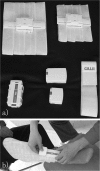Early application of pulsed electromagnetic field in the treatment of postoperative delayed union of long-bone fractures: a prospective randomized controlled study
- PMID: 23331333
- PMCID: PMC3556314
- DOI: 10.1186/1471-2474-14-35
Early application of pulsed electromagnetic field in the treatment of postoperative delayed union of long-bone fractures: a prospective randomized controlled study
Abstract
Background: Pulsed electromagnetic field (PEMF) is reported to be an effective adjunct for the management of nonunion long-bone fractures. Most studies implement PEMF treatment after 6 months or longer of delayed union or nonunion following fracture treatment. Despite these variations in treatment, the early application of PEMF following a diagnosis of a postoperative delayed union has not been specifically analyzed. In this study, the outcomes of postoperative delayed union of long-bone fractures treated with an early application of PEMF were evaluated as compared with a sham-treated control group.
Methods: In this prospective, randomized controlled study, a total of 58 long-bone fracture patients, who presented with delayed union of between 16 weeks and 6 months, were randomly split into two groups and subjected to an early application of PEMF or sham treatment. Clinical and radiological assessments were performed to evaluate the healing status. Treatment efficacy was assessed at three month intervals.
Results: Patients in the PEMF group showed a higher rate of union than those in the control group after the first three months of treatment, but this difference failed to achieve statistical significance. At the end of the study, PEMF treatment conducted for an average of 4.8 months led to a success rate of 77.4%. This was significantly higher than the control, which had an average duration of 4.4 months and a success rate of 48.1%. The total time from operation to the end of the study was a mean of 9.6 months for patients in the PEMF group.
Conclusions: Fracture patients treated with an early application of PEMF achieved a significantly increased rate of union and an overall reduced suffering time compared with patients that receive PEMF after the 6 months or more of delayed union, as described by others.
Figures




Similar articles
-
Pulsed electromagnetic field stimulation for acute tibial shaft fractures: a multicenter, double-blind, randomized trial.J Bone Joint Surg Am. 2011 Sep 7;93(17):1569-76. doi: 10.2106/JBJS.J.00869. J Bone Joint Surg Am. 2011. PMID: 21915570 Clinical Trial.
-
Pulsed electromagnetic fields for the treatment of tibial delayed unions and nonunions. A prospective clinical study and review of the literature.J Orthop Surg Res. 2012 Jun 8;7:24. doi: 10.1186/1749-799X-7-24. J Orthop Surg Res. 2012. PMID: 22681718 Free PMC article. Review.
-
Treatment of delayed- and non-union of fractures using pulsed electromagnetic fields.J Biomed Eng. 1988 Jul;10(4):301-4. doi: 10.1016/0141-5425(88)90058-1. J Biomed Eng. 1988. PMID: 3266275
-
Pulsed electromagnetic field (PEMF): A potential adjuvant treatment for infected nonunion.Med Hypotheses. 2020 Mar;136:109506. doi: 10.1016/j.mehy.2019.109506. Epub 2019 Nov 18. Med Hypotheses. 2020. PMID: 31841766
-
The development and application of pulsed electromagnetic fields (PEMFs) for ununited fractures and arthrodeses.Clin Plast Surg. 1985 Apr;12(2):259-77. Clin Plast Surg. 1985. PMID: 3886262 Review.
Cited by
-
Treatment Effect of Platelet Gel on Reconstructing Bone Defects and Nonunions: A Review of In Vivo Human Studies.Int J Mol Sci. 2022 Sep 27;23(19):11377. doi: 10.3390/ijms231911377. Int J Mol Sci. 2022. PMID: 36232679 Free PMC article. Review.
-
Pulsed Electromagnetic Fields in Bone Healing: Molecular Pathways and Clinical Applications.Int J Mol Sci. 2021 Jul 9;22(14):7403. doi: 10.3390/ijms22147403. Int J Mol Sci. 2021. PMID: 34299021 Free PMC article. Review.
-
Nature's Electric Potential: A Systematic Review of the Role of Bioelectricity in Wound Healing and Regenerative Processes in Animals, Humans, and Plants.Front Physiol. 2017 Sep 4;8:627. doi: 10.3389/fphys.2017.00627. eCollection 2017. Front Physiol. 2017. PMID: 28928669 Free PMC article. Review.
-
Lateral tibial plateau autograft in revision surgery for failed medial unicompartmental knee arthroplasty.Knee Surg Sports Traumatol Arthrosc. 2017 Mar;25(3):773-778. doi: 10.1007/s00167-015-3610-z. Epub 2015 Apr 24. Knee Surg Sports Traumatol Arthrosc. 2017. PMID: 25906913
-
Osteogenesis Stimulator Devices Reduce Surgical Intervention, Opioid Utilization, and Overall Costs in Patients with Fracture Nonunions.Orthop Rev (Pavia). 2023 Nov 22;15:88398. doi: 10.52965/001c.88398. eCollection 2023. Orthop Rev (Pavia). 2023. PMID: 38025826 Free PMC article.
References
Publication types
MeSH terms
LinkOut - more resources
Full Text Sources
Other Literature Sources
Medical

